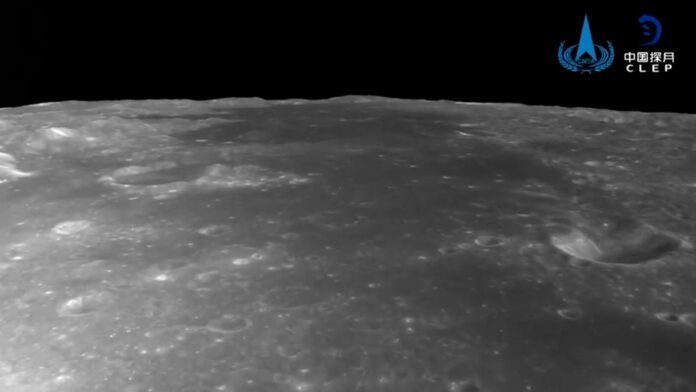China’s Chang’e-6 probe has successfully landed on the far side of the Moon. Launched on May 3rd aboard the Long March 5 rocket, the Chang’e-6 (pronounced Chang-uh-6) mission aims to collect samples from a massive crater and return them to Earth. This groundbreaking mission, undertaken by the China National Space Administration (CNSA), marks another significant step in lunar exploration.
A Historic Landing in the South Pole-Aitken Basin
Chang’e-6 has landed in the South Pole-Aitken Basin, one of the largest known impact craters in the solar system. This mission is the first attempt to gather samples from this rarely explored region of the Moon. Previously, China achieved another milestone with the Chang’e-4 mission, which successfully landed on the Moon’s far side in January 2019. If all goes as planned, Chang’e-6 will mark a new chapter in China’s space exploration history.

Mission Objectives and Sample Collection
The primary goal of the Chang’e-6 mission is to collect approximately 2 kilograms of lunar soil and rock samples from both the surface and up to 2 meters below it. This collection process will involve two different methods: a drill to extract subsurface samples and a robotic arm to gather surface materials. After the samples are collected, a rocket will launch them into lunar orbit. There, the samples will be transferred to the Chang’e-6 orbiter, which will then return them to Earth. The mission aims to have the samples back on Earth by June 25th, landing via parachute.
In addition to the primary mission, Chang’e-6 carries a small lunar rover and various scientific experiments. These experiments will help scientists gain insights into the history and evolution of the Moon and understand why the far side is so different from the near side.
Overcoming Communication Challenges
Exploring the Moon’s far side presents unique challenges, particularly in communication. To facilitate the Chang’e-6 mission, China launched relay satellites, including the Queqiao-2, to ensure continuous communication with the far side of the Moon. These relay satellites played a crucial role in the mission’s success.
Scientific Significance
The samples collected by Chang’e-6 will be compared with those gathered by the Chang’e-5 mission from the Moon’s near side. This comparison will provide valuable information about the differences between the two sides of the Moon. Scientists hope to uncover clues about the Moon’s formation and the processes that shaped its geological history.

China’s Rapid Advancement in Space Exploration
China’s space program has made significant strides over the past 17 years, rapidly catching up with the capabilities of the United States and Russia. China has successfully deployed robotic explorers to Mars and the Moon and is the third country to independently send humans into orbit. The Chang’e-6 mission brings China closer to becoming the first country to collect samples from the Moon’s far side.
Looking ahead, China plans to send a crewed mission to the Moon by 2030 and establish a lunar base. Meanwhile, the United States aims to send astronauts to the Moon by 2026 as part of the Artemis 3 mission.

Summary Table
| Aspect | Details |
|---|---|
| Mission Name | Chang’e-6 |
| Launch Date | May 3, 2024 |
| Landing Site | South Pole-Aitken Basin |
| Primary Objective | Collect lunar soil and rock samples from the far side of the Moon |
| Sample Collection | Approximately 2 kilograms from surface and subsurface (up to 2 meters deep) |
| Sample Return | Return to Earth by June 25, 2024 |
| Relay Satellite | Queqiao-2 |
| Additional Payloads | Small lunar rover and various scientific experiments |
| Scientific Goals | Understand the differences between the Moon’s near and far sides, and gain insights into lunar formation |
| China’s Space Achievements | Mars and Moon robotic missions, independent human spaceflight |
| Future Plans | Crewed mission to the Moon by 2030, establishment of a lunar base |
| US Space Goals | Artemis 3 mission to send astronauts to the Moon by 2026 |
China’s Chang’e-6 mission represents a significant advancement in lunar exploration, demonstrating the country’s growing capabilities in space science and technology. The mission not only aims to bring back valuable lunar samples but also paves the way for future manned missions and potentially a permanent presence on the Moon.

